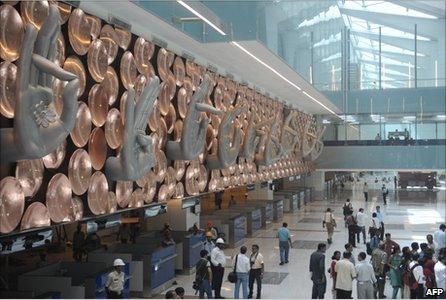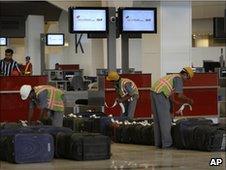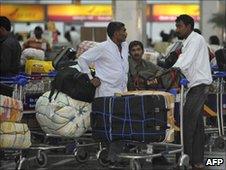Delhi opens huge new airport terminal
- Published

Terminal 3 at Delhi Indira Gandhi International Airport is the largest in India
Made of glass and steel, the swanky new Terminal 3 at Delhi's international airport is surrounded by dust and debris.
India is out to impress the world with this mega-structure.
Completed in record time, this is what the country hopes to show-off to the world when visitors arrive for the Commonwealth games 2010 later this year.
It is all about the sheer size and scale, billed as one of the largest airports in the world.

Building the airport has required thousands of workers
It is certainly bigger than anything India has ever seen. The terminal building is larger than the new terminals of Mumbai, Hyderabad and Bangalore combined.
It has eight levels, with a built-up area of 5.5 million square feet and an apron area of 6.3 million sqare feet.
The common check-in concourse has 168 check-in counters and 98 immigration counters for international passengers.
The terminal also has 78 aero bridges and a 100-room transit hotel.
Prabhakar Rao is the head of airport development for Delhi international Airport, or Dial.
He hopes that Delhi will become a regional hub.
"Why should people go to Dubai or Changi as a regional hub, when Delhi is ready for them? I want to tell people come here and let us serve you instead," he says.
Passenger traffic rates in India are among the highest in the world and are expected to double over the next five years.
Invite to business
As it is getting ready to open for business, the capacity of the airport has been increased to handle 60 million passengers per year and 75 aircrafts per hour.
The current airport handles less than half that number.
"We should not be building infrastructure for today's needs," says Mr Rao. "It should be built for the future.
"Given the projected traffic growth, the capacity of the terminal is optimum. When we build the capacity, we automatically invite the business.
Price worth paying

Trial runs have been held to test the airport's luggage handling system
The swanky new facilities are miles ahead of the existing Delhi airport.
It is seen as a symbol of new India setting an example for public-private partnerships.
Building costs have exceeded $2.7bn, higher than the earlier projected cost of $2bn.
This has resulted in a funding shortfall, some of which will be paid for by charging travelers a higher airport user development fee.
Passengers are already paying a user fee, but now passengers and airlines may have to pay more to use the new airport.
Many budget carriers have expressed concerns about a potential increase in charges for landing, parking and navigation fees.
But some passengers, such as frequent traveller Samir Singh, who flies between Bangkok and Delhi at least three times a month, say they do not mind paying more.
A trader who travels with a lot of luggage, Mr Singh thinks the new airport will mean faster entry and exit and easier access to his baggage.
Housewife Paromitra Banerjee agrees.
She frequently travels with her two young children to London and France to meet her family.
"If there are better and cleaner facilities for passengers, I wouldn't mind paying. Right now, it's just not a children friendly airport. I hope there are going to be play areas, more eateries and shopping areas where one can buy emergency products if necessary."
Major contracts
Delhi International Airport is a joint venture consortium led by GMR with a 54% stake.

Travelers say they are prepared to pay more for a better airport
The Airports Authority of India has a 26% stake, Fraport holds 10% and Malaysia Airport owns the remaining 10% of the shares.
A multinational team of almost 30,000 workers have been involved in the construction of the building.
The scale of the project means it has presented huge business opportunities for a whole range of companies.
The terminal has been designed by London architects HOK International. Another UK based firm, Brintons, supplied the 170,000 sqare metres of carpet material. It is said to be one of the largest carpet orders in the world.
The duty-free outlets contract has gone to a joint venture company led by the Irish travel retailer Aer Rianta and its local partner Indian Duty Free Services.
Aer Rianta was involved in setting up one of the largest duty free operators in the world, the Dubai Duty Free, and also runs retail units in major airports in Europe, Eastern Europe and North America.
The 20,000 square metres of retail space will offer more than 1,000 brands - a mixture of Indian brands and international brands such as Versace, Mango, Swarovski and Marks and Spencer.
Proud development
A group of workers are busy walking around with hand-held thermometers to check the air conditioning levels in different corners of the terminal.
Dubai-based ETA Engineering has been working on the air conditioning and plumbing of the new integrated domestic and international passenger terminal.
R. K. Sahu is the senior project manager of the company in charge of the airport work.
He has been involved in numerous projects in the Middle East, but says this is the biggest infrastructure work in India that the company has been involved in.
"It's a fantastic project to be involved in," he says.
"Every engineer, supervisor and worker felt proud to be working on it.
Such projects also help stop the brain-drain from the country. Prior to this we just didn't have opportunities like this to showcase our talent and use the latest technology.
"With this, everything has changed and hopefully this will set the trend for future infrastructure projects in the country."
The country's largest telecom firm, Bharti Airtel, is providing the telephony and mobile services in the new terminal.
This includes public call booths for domestic and international calls, charging stations for laptops and mobile phones and service desks to buy local phone cards.
Experts have been brought in from Munich's international airport to help prepare the airport in the transfer from the old terminal to the new.
The team has been training staff from the airlines, ground handlers and government agency staff like CISF, Immigration, and Customs from the existing terminals to familiarise them with the operations in the new building.
Testing the terminal
Sprawled around the arrival and departure areas are thousands of bags and old suitcases filled with old clothes and junk.
This is part of a mock baggage handling run, where the bags are piled onto trolleys, taken around the terminal, put on conveyor belts and examined through screening machines.
The fully automated baggage handling system is said to be able to handle 12,800 bags in an hour.
People have also been involved intrial runs in the new airport.
Some 15,000 volunteers pretending to be passengers and staff have been going through the terminal, testing every facility including the customs and immigration checks.
Final polish
The airport has set new standards in the construction business in the country with importance being given to greener and more eco-friendly materials.
French company Saint-Gobain Gyproc has built the prefabricated walls and false ceilings around the terminal.
The marketing manager of the company, N. E. Subramanian, says the project has forced suppliers local vendors to raise the bar when it comes to the quality of their products.
"For all the companies involved, the work we have done in the terminal has become a showcase for our other clients."
The airport is now getting its final polish before the doors open for the first passengers.
The terminal will be opened for international operations from 14 July and for domestic operations from 31 July.
Building India's lifelines has suddenly picked up pace. Long ignored, infrastructure projects are now being seen as huge opportunities for attracting investment and creating jobs.
India has set a target of having 500 operational airports in the next decade.
And if this project is anything to go by, the country's infrastructure looks like it is finally ready to take off.